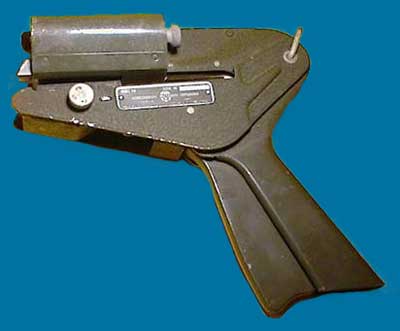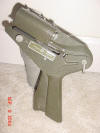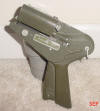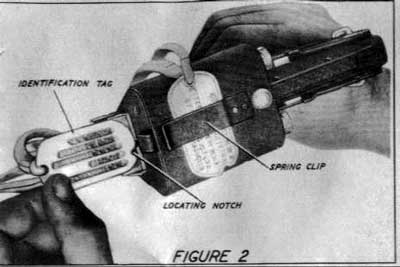Addressograph Model 70

Authentic WWII Notched
dog tags are available custom imprinted with your
information thru our on-line
catalog.
Please visit
our on-line
catalog
to purchase notched dog tags.

ADDRESSOGRAPH MODEL 70 and the "NOTCH"
The Addressograph Model 70 Medical Imprinter was designed for one sole
purpose and that was to transfer the imprinted
information on dog tags onto military paperwork.
To
facilitate the proper orientation of the imprinted
information on to the military paperwork the
Addressograph Model 70 utilized the "notch" in the
WWII, Korean and Viet Nam dog tags to properly
orient and locate the tag for the imprinted
transfer of information.
The imprinted dog tag will only fit into the
Addressograph Model 70 one way and fully seat into
the proper position. Once seated in the proper
position the Addressograph Model 70 will then
operate and the information imprinted on a given tag
can be transferred to the paperwork much like old
credit card receipt machines transferred embossed
credit card information onto paper receipts.
If
a imprinted dog tag is inserted into the
Addressograph Model 70 backwards, upside down or
incorrectly it will not properly seat into the
operating position on the Addressograph Model 70 and
the device will not work.
The answer the question for all those wanting to know
what the "notch" in the dog tag was for -
is simple, it was a locating notch used to properly
orient the "imprinted" dog tag in the Addressograph
Model 70.
Simply put - there is NO other use for the notch and
the military engineers that drafted the
specifications and drawings for the military
identification tags known as dog tags had no other
intentions when they designed in the "notch" other
than for the Addressograph Model 70.
Information on the Addressograph Model 70
-
The Addressograph
Model 70's sole function was to transfer
imprinted information onto military paperwork.
-
The Addressograph
Model 70 could not imprint, deboss or emboss dog
tags. The Addressograph Model 70 had only
a rubber pad and a inked ribbon so that the
imprinted information could be transferred to
paperwork.
-
The Addressograph
Model 70 did not have any punches or dies and
could not imprint information onto a blank tag
or plate.
NOTICE -
***
DogTagsRus
just purchased an
Addressograph Model 70.***
The Addressograph Model 70 is here !!!!!!!!!!!!!
As soon as we have time to
review and inspect the device we will be taking
detailed photographs and preparing a full technical
write up to be made available here. Check back
often, information will be updated as soon as it is
available.

This is a photo of the unit we purchased this
photo came from the seller.

Here is a close up of the data plate clearly
indicating "Model 70"

This photo is from the seller.
The Addressograph Model 70 is the
medical imprinter that used the notch on the WWII
military dog tags, this "notch" was actually a
"locating notch" and is referred to in both
Addressograph and government documentation as
"locating notch." The Model 70 was issued to
medics in the field during WWII. The purpose
of the Model 70 was to allow the medic to take a
soldiers identification tag and transfer the
information on the tag to medical documents by
imprinting the text directly onto the document.
The Model 70 would accept a notched dog tag and
would then transfer the information on the soldiers
dog tag to medical paperwork in the field.

Addressograph Model
70
The Addressograph Model 70 is a
"pistol" shaped device that was issued to the
medic's in the field during WWII. The medic
would load a soldiers notched dog tag into the front
of the device using the notch to locate and orient
the tag in the model 70. With a squeeze of the
handle the unit would imprint the dog tag
information on a document with a carbon or
typewriter like ribbon.
 The
unit works much like the manual credit card
imprinter that is used to imprint your credit card
information onto a sales slip. You insert the
credit card in the imprinter and slide the handle
"bridge" across the credit card and sales slip and
it imprints your credit card information onto the
sales slip.
The
unit works much like the manual credit card
imprinter that is used to imprint your credit card
information onto a sales slip. You insert the
credit card in the imprinter and slide the handle
"bridge" across the credit card and sales slip and
it imprints your credit card information onto the
sales slip.

This photo shows the
proper loading and orientation of the identification
tag using the "locating notch" on the Addressograph
Model 70. The tri-angular section with the
"spring clip", is where the ribbon is located that
transferees ink to the paper document which leaves
the permanent text.

The area highlighted
in blue shows how the text appeared on a document
that was imprinted using the Addressograph Model 70
and an identification tag. Notice you can
faintly make out the border of the identification
tag on the right hand side of the name.
Clearly you can see the radius and edge of the tag
in the upper right, the through hole for the
necklace and in the lower right you can faintly see
the bottom corner of the tag.
One description of the
Addressograph Model 70 says:
WWII Addressograph Printer, Model
70. This is a Medical Department item issued to
medics to print the information off of I.D. tags
onto wound tags. Tag is inserted in the top and the
tag in the bottom and the trigger is pulled, thus
capturing the information via carbon ribbon onto the
tag.
Official nomenclature of the
Addressograph Model 70 is said to be:
Addressograph pistol-type imprinting
machine, Model 70, Medical Department Item # 99387
Technical Information
on the Addressograph Model 70:
a. The Addressograph
Model 70 weighs, xxx lbs.
b. The color of the Model 70 is Olive Drab Green
c. There are two styles of paint on the
Addressograph Model 70, The upper body and 1/2 of
the lower body utilize a crinkle finish type paint,
while the ribbon shroud and the handle and pistol
grip are a smooth paint.
d. Body and part of of sheet metal or castings.
Castings have minimal finish machining, most areas
are as cast with no clean up. All sheet metal
has sharp edged removed.
e. The Model 70 is assembled with riviets and
screws.
Key features
1. Feed reel and Take up reel with knobs for inked
ribbon:
The feed reel for the
ribbon is located under a sheet metal removable
shroud. To the rear of the feed reel there is
a knob that protrudes out of the housing. The
knob is knurled aluminum and is marked with a
circular arrow to indicate the direction the take up
reel should be wound for proper operation.
The take up reel is
located under a sheet metal removable shroud and is
on the right hand side of the unit. The
tension knob is located to the rear of the reel and
is outside the take up reel housing. The
aluminum knob is knurled and is marked with a
circular arrow to indicate the direction the
operator should wind the take up reel.
The feed and take up
reels are spring loaded for tension to prevent the
reels from rotating freely. The operator must
advance the ribbon by manually rotating the knurled
knobs located on either side of the unit.
2. Inked ribbon:
The inked ribbon is
used to transfer the information from the
identification plates to desired paperwork.
The inked ribbon is 1-3/4" wide and appears to be
about 20 feet long. The ribbon itself is much
like a heavy cloth ribbon one would find in an old
manual typewriter. The ribbon material has the
consitency of a very heavy semi-thick cotton cloth
much like a standard inked stamp pad found in many
offices. Ribbon is saturated with a very heavy
black ink. The ribbon feeds from left to right
from a feed reel to a take up reel.
3. Addressograph Model 70 name plate:
The Identification
plate or name plate is made of thin strip aluminum.
It is rectangular in shape and is approximately
22x22 in size. The identification / data plate
is located on the left hand side of the unit in the
middle of the body. The plate contains the
following information:
MODEL
70
SERIAL NO. 72691
ADDRESSOGRAPH MULTIGRAPH CORPORATION
CLEVELAND
OHIO
MADE IN USA
PAT NO. 2 16235 AND OTHERS
The name plate is held
to the body by two rivets.
4. Line imprinting
selector:
The line imprinting
selector is an interesting feature of the
Addressograph Model 70. There are three
settings that the operator can select on the fly.
The small aluminum knob is marked with the numbers
"2", "5", and "3". The operator can select "2"
and the unit will imprint only the first two lines
of information. If the "5" is selected the
model 70 will imprint all five lines of the
identification tag. When "3" is selected the
Addressograph will only print the three last lines
of the tag, used if the operator wanted to only
capture the "Next of Kin" information.
At the three o' clock
position is a indicating notch that shows the
operator which embossing selection is currently
engaged.
The line selector
rotates a shaft that has ground flats that when
rotated either engage or dis-engage the imprinting
blocks.
5. Pistol Grip and
squeeze handle:
The Addressograph
Model 70 has a pistol grip that protrudes down from
the main upper and lower bodies of the unit.
The pisol grip is located at the rear of the unit
just below the piviot point. There is a
squeeze handle that follows the foward contour of
the pistol grip and is actually protruding through
the front of the pistol grip.
The squeeze handle is
as its name implies a handle that is squeezed to
make the Addressograph Model 70 imprint.
Inside the pistol grip between the heal of the grip
and squeeze handle is a heavy main spring that
returns the squeeze handle to its outward position
after use.
The squeeze handle is
cast aluminum and is solid with a contoured shape to
fit the human hand.
6. Tag guide:
The tag guide is of
bent sheet metal that protrudes 0.300" from the
front of the unit. The tag guide is formed to
make a flat "U" shaped tray or guide. The
operator places a identification tag or dog tag into
the starting lips of the tag guide and then presses
the entire tag into the center section of the unit.
The dog tag will then proceed to follow the tag
guide until the locating notch in the tag bottoms
out on the notch pin.
The tag guide has a
spring steel tensioner that allows the tag to be
pressed in and removed but does not allow the tag to
fall out of the unit.
7. Notch locating pin:
This is the one
feature of the machine that has caused so much
contreversy. The locating pin is pressed into
the aluminum stamping block of the upper housing.
The locating pin protrudes downward approimately
0.050"- 0.060" from the aluminum block.
It is this locating
pin that locates on the notch in the WWII, Korean
and Vietnam dog tags or identification tags.
If a tag is inserted into the machine upside down or
incorrectly and the locating notch does not bottom
out on the locating pin the tag will not print
correctly.
This pin is the only
reason for the notch in the WWII style military dog
tags.
8. Stamping blocks:
The Addressograph
Model 70 has three sets of cast aluminum stamping
blocks. There is one upper block and two lower
blocks.
The upper block is
fixed and does not move. The upper block is
permanently located in the upper housing and forms a
flat working surface for the identification tag.
The upper block is where the tag locating pin is
located.
On the lower body
there are two stamping blocks. The lower
stamping blocks are located inside the main portion
of the lower body within the hollow center of the
front section. One stamping block is
approximately 0.350" wide while the other is 0.525"
wide. The shorter of the two is used to
imprint the first two lines of informationtion from
a dog tag while the wider block will imprint the
last three lines of text. Both stamping blocks
are cast aluminum that has been finished machine
with a very dense heavy rubber attached on the top
flat of each block.
This rubber acts much
the same as a rubber stamp allowing the debossed
text of the dog tags to imprint ink from the ribbon
and to leave an impression on the stamped paper.
Both lower stamping
blocks operate indepenantly of each other and piviot
at the rear of the unit. The operator must
select which stamping blocks are to be used by using
the selector located on the left hand side of the
unit.
9. Carry ring:
There is a carry ring
located at the rear of the unit and is attached at
the piviot point between the upper and lower bodies.
The locating ring is rectanglar shaped. The
ring rotates freely about the piviot point and is
non-removable.
10. Lower body:
The lower body
actually moves and piviots up and down. The
upper body is fixed and does not move. The
lower body is mainly composed of sheet metal and
stamped components. The lower body appears to
have much more mass than it actually does, the lower
body is comprised of two stamped metal side plates
joined together to form a arm that is primarily
hollow on the inside. Between these two side
plates are many of the internal components such as
the stamping blocks, tension springs and adjustment
screws to mention a few.
11. Upper body:
The upper body is
sheet metal and a castings that has been finished
machined on selected surfaces. Cast into the
body on the upper spine of the unit are the words:
"MED. DEPT. U.S. ARMY". Located just in front
of the spine and words is a round spring loaded
catch that serves to hold the sheet metal shroud in
place. This sheet metal shroud covers the
inked ribbon, feed reel and take up reel.
12. Sheet metal
shroud:
The sheet metal shroud
is semi-triangular in design with large radiused
corners. The sheet metal shroud covers the
inked ribbon, feed reel and take up reel. The
top of the shroud is flat with a notch at one end
and a shaped spring steel clip on the other end.
The slot is for locking the shroud to the body while
the spring clip is for holding a second
identification tag while it is not being used.
On the front or nose of the shroud there is a
locating clip that locates into a slot on the feed
and take up reel housing. The sheet metal
shroud is fabricated by spot welding.
Underside of the shroud is not painted, the outside
of the shroud is painted olive drab green. The
metal shroud is locked securly in place by both the
locating clip and the spring loaded catch.
Author Note:
After exstensive examination of the Addressograph
Model 70, the unit appears to be well built and
engineered for the rigors of field use. The
only exception is the sheet metal shroud that covers
the inked ribbon, feed reel and take up reel, this
shroud is the only weak point in the device.
The shroud is of thin sheet metal and if dropped or
bumped would dent easily. The shroud is held
in place by both the clip on the front and the
spring loaded catch at the rear but does move freely
when grasped by the hand. With the exstensive
use of castings and heavy metal stampings I think it
would have been a better choice to make the shroud
from heavier gauge material to give it more robust
properties and strength.
MEDICS IN WWII
In WWII Medics, Litter
Bearers, Aid Station peronnel and Aidmen were
supossed to be protected by the Geneva Convention
and were to be treated as Medical personnel and not
as combat soldiers. In essence the shooting of
any medical personnel was against the rules of the
Geneva Convention. There are several pages on
the Internet that cover the WWII medic in detail and
these links can be found in our
RESOURCES page.
Here at DogTagsRus
we are asked everytime we go to a show what the
Addressograph Model 70 looks like.
Why are there not many examples
of the Addressograph Model 70?
One theory
came from Mr. H. Brewer of H. H. Brewer Co., in
Tallahassee, Florida. Mr. Brewer owns a
WWII militaria shop that buys and sells WWII
militaria. Mr. Brewer told me that many of
these units were destroyed during WWII because the
Addressograph Model 70's were getting the medics
killed in the field. It seems that medics were
being shot by the Germans just as regular soldiers.
The Americans caught several German prisoners and
interviewed them to find out why they were shooting
the medics. The German prisoners said it is
because the medics were "armed." When
questioned further the German prisoners said the
medics were armed with pistols and as such they were
being shot as soldiers instead of medics.
Further
research and prisoner interviews determined that the
medics were carrying the Addressograph Model 70
imprinters and the imprinters were shaped like a
pistols so it appeared to the Germans that the
medics were "armed," with pistols or side arms.
Once confirmed the commanders in the field ordered
all their medics to dispose of their Addressograph
Model 70's in any manner they could. Mr.
Brewer indicated there were stories of medics
throwing their Model 70's in ditches all over the
European theater.
If in fact all of this is true about
the GI medics throwing their Model 70's in the trash
then in reality this was no real loss. Some of
the best ideas on paper don't work out in the field.
The Model 70 was a cantankerous machine, it required
maintenance, it required supplies (carbon ribbon),
it was extra weight and an additional piece of
equipment that the medic had to keep up with.
In reality the Model 70 maybe only saved a few
seconds over hand writing the text. The
printed results varied due to conditions and at
times were illegible to the point that hand writing
would have been a better alternative over the
imprinting.
With all the limitations the Model
70 had and the fact that it could be mistaken as a
pistol in the field by your enemy it most surely was
the right decision to disband this device if for
nothing else but self preservation.
While many of these Addressograph
Model 70's were destroyed by the medic's during WWII
there are still plenty of specimens that can be
found here in the states. Many of these units
have found homes in the hands of collectors, museums
and military enthusiasts.
It is speculated that there might
have been a canvas holster issued with this unit.
If anyone has information on any such holster for
the Addressograph Model 70 please e-mail us direct
at
info@dogtagsrus.com. We want to verify the
existence of any such holster for this unit.
DogTagsRus
has just purchased an Addressograph Model 70 Medical
Imprinter. We hope to be updating our
photographs of this unit as soon as we receive the
unit.
# # #
